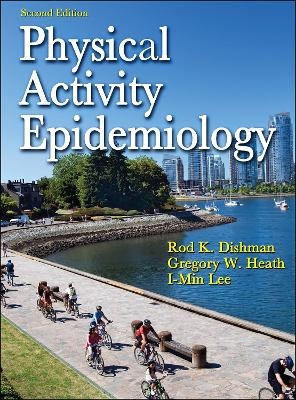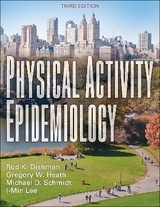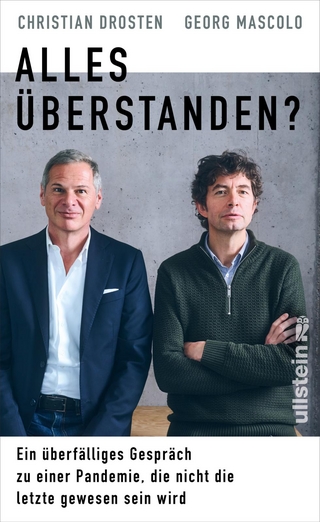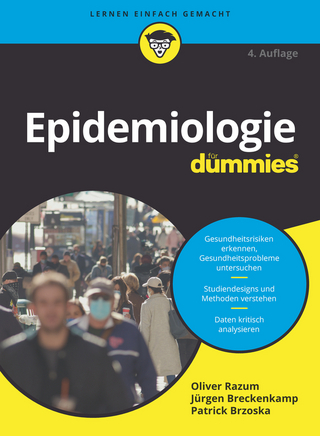
Physical Activity Epidemiology
Human Kinetics (Verlag)
978-0-7360-8286-0 (ISBN)
- Titel erscheint in neuer Auflage
- Artikel merken
Physical Activity Epidemiology, Second Edition, provides a comprehensive discussion of current population-level studies showing the influence of physical activity on disease. Updated with extensive new research collected in the eight years since the previous edition, the second edition adds the expertise of respected epidemiologist I-Min Lee. To assist readers in understanding the public health significance of physical activity, Dishman, Heath, and Lee present a detailed review of research findings and what those findings suggest regarding the relationship between physical activity and a variety of health risks.
The second edition of this groundbreaking text has been exhaustively updated to reflect the wealth of new research published in this fast-moving field of study. With more than 100 pages of additional content, the text also offers more detailed coverage of all-cause and coronary heart disease mortality, expanded coverage of pathophysiology and biological plausibility, new information on physical activity among various racial–ethnic populations, and the effects of physical activity on cognitive function, dementia, and HIV/AIDS. More than 250 tables and figures, twice the number found in the previous edition, highlight the latest epidemiological information in an easy-to-understand visual format.
Physical Activity Epidemiology, Second Edition, assists readers in understanding how leisure-time physical activity can enhance people’s quantity and quality of life by summarizing the available knowledge, detailing the methods used to obtain it, considering its implications for public health, and outlining the important questions that remain. Readers will find comprehensive discussion of these topics:
• Evidence that physical activity protects against the development of coronary heart disease and stroke and premature death from all causes
• Population-based studies and clinical experiments providing evidence that physical activity and exercise play a role in the primary and secondary prevention of mild hypertension, dyslipidemia, and obesity
• Contemporary epidemiologic evidence that physical activity reduces the risk of type 2 diabetes and osteoporosis and protects against the development of breast and colon cancers, some inflammatory diseases, depression, and anxiety disorders
• Considerations in the promotion of a safe, physically active lifestyle among all segments of the population
Physical Activity Epidemiology, Second Edition, will engage and challenge students by examining the state of current research in all of its variation and even ambiguity. The text details the methodology and findings of classic and contemporary studies and then helps students begin to analyze the results. Special Strength of the Evidence sections found at the end of most chapters summarize the findings to determine the extent to which correlation and causation can be proven. Chapter objectives, chapter summaries, and sidebars in each chapter assist students in focusing on the key points of study, and an extensive glossary with detailed definitions provides a handy reference for review. Instructors will find a new image bank in this edition to enhance their class lecture materials.
Physical Activity Epidemiology, Second Edition, offers students, sport and exercise scientists, health and fitness professionals, andd public health administrators a comprehensive presentation of significant studies, how these studies contribute to understanding the relationship between activity and disease prevention, and how this information can be used in leading individuals, communities, and global society toward increased health and longevity.
Rod K. Dishman, PhD, is a professor of exercise science, adjunct professor of psychology, and the director of the Exercise Psychology Laboratory at the University of Georgia at Athens. He is also adjunct professor in the Arnold School of Public Health at the University of South Carolina at Columbia. Dr. Dishman is a reviewer for more than 50 journals, including Journal of the American Medical Association (JAMA) and American Journal of Public Health. He has served on editorial boards of numerous journals in preventive medicine and public health, such as Exercise and Sport Science Reviews, Medicine & Science in Sports & Exercise, and Health Psychology and as an exercise consultant to public health agencies in the United States, Canada, and Europe. He has published approximately 150 peer-reviewed articles and written or edited several books related to physical activity and health. Dr. Dishman is an American College of Sports Medicine fellow, where he has served as a member of the Research Advisory Committee and the Board of Trustees. He was a member of the jury for selection of the Olympic Prize in Sport Sciences awarded by the International Olympic Committee's Medical Commission and served on the scientific advisory committee for the 2008 Physical Activity Guidelines for Americans. He resides in Athens, Georgia. Gregory Heath, DHSc, MPH, has been contributing to the field of exercise science and health promotion for over 25 years. Dr. Heath is Guerry professor and head of the department of health and human performance at the University of Tennessee at Chattanooga. Previously, he worked at the Centers for Disease Control and Prevention as lead health scientist in the Physical Activity and Health Branch. He has extensive experience in conducting studies and data analyses in the areas of physical activity epidemiology and public health practice. Dr. Heath is a fellow in the Council on Epidemiology and Prevention, the American Heart Association, and the American College of Sports Medicine. He earned his doctor of health science degree in applied physiology and nutrition and his master's of public health in epidemiology from Loma Linda University. I-Min Lee, MBBS, MPH, ScD, is an associate professor of medicine at Harvard Medical School, an associate professor of epidemiology at Harvard School of Public Health, and associate epidemiologist at Brigham and Women's Hospital in Boston. Her main research interest is in the role of physical activity in promoting health and preventing chronic disease. This extends to characteristics associated with a physically active way of life, such as maintenance of ideal body weight. She also is concerned with issues relating to women's health. Lee has published more than 190 peer-reviewed articles and is a frequent invited presenter, teacher, and speaker at local, national, and international levels. A reviewer for 30 journals, including Lancet and New England Journal of Medicine, Lee also serves on the editorial board for Harvard Women’s Health Watch, Medicine & Science in Sports & Exercise, and the Brazilian Journal of Physical Activity and Health. Lee is an elected member of the American Epidemiological Society and a member of the Society for Epidemiologic Research, the American Heart Association, and the International Society for Physical Activity and Health. She is a member and fellow of the American College of Sports Medicine (ACSM) and has served on the ACSM’s Research Advisory Committee and Board of Trustees. Dr. Lee also served on the scientific advisory committee for the 2008 Physical Activity Guidelines for Americans. Lee is the recipient of numerous awards and recognitions, in particular the Young Epidemiologist Award from the Royal Society of Medicine in the United Kingdom (1999); the William G. Anderson Award from the American Alliance for Health, Physical Education, Recreation and Dance (2007); the Charles C. Shepard Award from the Centers for Disease Control and Prevention (2009); and the ACSM’s Citation Award (2011). Lee resides in Brookline, Massachusetts.
Part I. Introduction to physical Activity Epidemiology
Chapter 1. Origins of Physical Activity Epidemiology
Ancient History of Physical Activity and Health
Modern History of Physical Activity and Health
Physical Activity for Health Promotion in the United States and the World
Summary
Bibliography
Chapter 2. Concepts and Methods in Physical Activity Epidemiology
Epidemiologic Measures
Crude, Specific, and Standardized Rates
Research Design in Epidemiologic Studies
Evaluating Associations in Epidemiologic Studies
Models in Physical Activity Epidemiology
Inferring Cause in Epidemiologic Studies
Criteria for Causation
Summary
Bibliography
Chapter 3. Measurement and Surveillance of Physical Activity and Fitness
Why Is Behavioral Epidemiology Important?
What Is Physical Activity?
Measures of Physical Activity
What Is Physical Fitness?
Surveys and Surveillance of Physical Activity
Summary
Bibliography
Part II. Physical Activity and Disease Mortality
Chapter 4. All-Cause Mortality
Life Expectancy at Birth
Major Causes of Mortality
Physical Activity and All-Cause Mortality
Sedentary Behavior and All-Cause Mortality
Physical Fitness and All-Cause Mortality
Changes in Physical Activity or Fitness and All-Cause Mortality
Are the Associations Real?
Strength of the Evidence
How Much Physical Activity Is Needed to Decrease Risk of Premature Mortality?
Summary
Bibliography
Chapter 5. Coronary Heart Disease
History and Magnitude of the Problem
Coronary Heart Disease Risk Factors
Coronary Heart Disease Etiology
Physical Activity and Coronary Heart Disease
Sedentary Behavior and Coronary Heart Disease Risk
Physical Fitness and Coronary Heart Disease Risk
Individuals With Other Risk Factors or Existing Coronary Heart Disease
Physical Inactivity Compared With Other Risk Factors
Are the Associations Real?
Strength of the Evidence
How Much Physical Activity Is Needed to Decrease Coronary Heart Disease Risk?
Summary
Bibliography
Chapter 6. Cerebrovascular Disease and Stroke
Magnitude of the Problem
Risk Factors for Stroke
Etiology of Stroke
Physical Activity and Stroke Risk: The Evidence
Strength of the Evidence
Summary
Bibliography
Part III. Physical Activity and Risk Factors
Chapter 7. Physical Activity and Hypertension
Magnitude of the Problem
Treating Hypertension
Hypertension Etiology
Autonomic Nervous System
Physical Activity and Reduced Hypertension Risk: The Evidence
Physical Activity and Treatment of Hypertension: The Evidence
Strength of the Evidence
Summary
Bibliography
Chapter 8. Physical Activity and Dyslipidemia
Magnitude of the Problem
Drug Treatment
Dyslipidemia Etiology and Physical Activity
Physical Activity and Lipoprotein Levels: The Evidence
Strength of the Evidence
Summary
Bibliography
Chapter 9. Physical Activity and Obesity
Magnitude of the Problem
Treatment of Overweight and Obesity
Assessing and Defining Overweight and Obesity
Etiology of Overweight and Obesity: Set Point or Settling Point?
Physical Activity and Fitness and the Health Risks of Obesity: The Evidence
Physical Activity and Prevention of Excess Weight Gain: The Evidence
Physical Activity and Weight Loss: The Evidence
Physical Activity and Weight Maintenance: The Evidence
The Ultimate Goal: Weight Loss or Risk Reduction?
Summary
Bibliography
Part IV. Physical Activity and Chronic Diseases
Chapter 10. Physical Activity and Diabetes
Magnitude of the Problem
Demographics of Diabetes
Clinical Features
Health Burden of Diabetes
Risk Factors
Insulin and Glucose Transport
Etiology of Type 2 Diabetes
Effects of Physical Activity on Diabetes Risk: The Evidence
Strength of the Evidence
Summary
Bibliography
Chapter 11. Physical Activity and Osteoporosis
Magnitude of the Problem
Fractures and Mortality
Etiology of Osteopenia and Osteoporosis
Risk Factors and Prevention
Bone Measurement Techniques
Physical Activity and Osteoporosis: The Evidence
Strength of the Evidence
Summary
Bibliography
Part V. Physical Activity, Cancer, and Immunity
Chapter 12. Physical Activity and Cancer
Magnitude of the Problem
Etiology of Cancer
Risk Factors
Population Studies of Physical Activity: Specificity of Protection?
Colon and Rectal Cancer
Breast Cancer
Other Cancers
Physical Activity and Cancer Survivors
Summary
Bibliography
Chapter 13. Physical Activity and the Immune System
An Abridged History of Immunology
HIV and AIDS
The Immune System
Immunomodulation by the Nervous and Endocrine System
Physical Activity and Immunity: The Evidence
Mechanisms of Alterations in Monocytes, Granulocytes, and Natural Killer Cells After Acute Exercise
Exercise and Cytokines
Summary
Bibliography
Part VI. Physical Activity and Special Concerns
Chapter 14. Physical Activity and Mental Health
Depression
Magnitude of the Problem
Results From the National Comorbidity Survey
Etiology of Depression
Brain Neurobiology in Depression
Treatment of Depression
Physical Activity and Depression: The Evidence
Anxiety Disorders
Magnitude of the Problem
Etiology of Anxiety Disorders
Brain Neurobiology in Anxiety Disorders
Treatment of Anxiety Disorders
Physical Activity and Anxiety: The Evidence
Cognitive Function and Dementia
Physical Activity and Cognitive Function: The Evidence
Summary
Bibliography
Chapter 15. Physical Activity and Special Populations
Physical Activity Among Diverse Racial–Ethnic Populations
Physical Activity and Disability
Inactivity and Aging
Physical Activity and Long-Term Health Amoung People With Disabilities
Role of Physical Activity in the Prevention of Secondary Complications
Summary
Bibliography
Chapter 16. Adverse Events and Hazards of Physical Activity
Magnitude of the Problem
Evaluating Risk
Methods of Research
Myocardial Infarction and Sudden Death
Joint and Muscle Injury
Injury Features
Risk of Physical Activity Injuries: The Evidence
Other Medical Hazards
Psychological Hazards
Summary
Bibliography
Chapter 17. Adopting and Maintaining a Physically Active Lifestyle
Individual Barriers to Physical Activity
How Do People Decide to Be Active?
Environmental Barriers to Physical Activity
Genetics of Physical Activity
Environmental Intervention and Self-Regulation
Effectiveness of Physical Activity Interventions
Interventions to Increase Physical Activity
Mediators and Moderators of Physical Activity Change and Interventions
Features of Physical Activity That Promote Adoption and Maintenance
Summary
Bibliography
| Verlagsort | Champaign, IL |
|---|---|
| Sprache | englisch |
| Maße | 216 x 279 mm |
| Gewicht | 1860 g |
| Themenwelt | Studium ► Querschnittsbereiche ► Epidemiologie / Med. Biometrie |
| ISBN-10 | 0-7360-8286-7 / 0736082867 |
| ISBN-13 | 978-0-7360-8286-0 / 9780736082860 |
| Zustand | Neuware |
| Haben Sie eine Frage zum Produkt? |
aus dem Bereich



